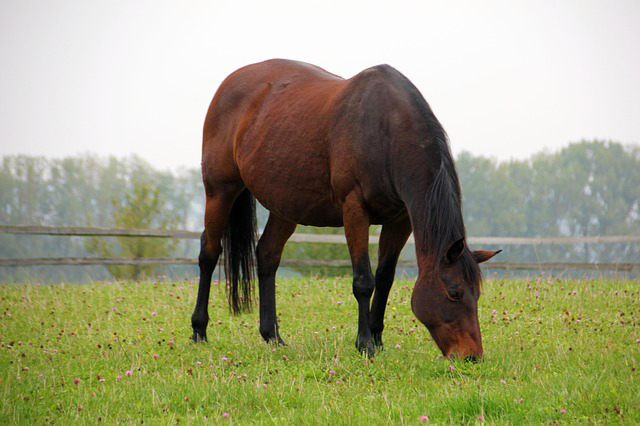Low Glycemic Index is One Advantage of this Miracle Feed
By Eleanor Blazer
High in digestible fiber, low glycemic index, 10% crude protein. What is this miracle horse feed? Beet pulp!
After sugar is extracted from beets the leftover pulp is a form of highly digestible fiber suitable for horses. Beet pulp contains 18% crude fiber, which puts it on the borderline of being classified as forage.
The equine digestive system is designed to utilize fiber. The cecum, which is part of the large intestine, contains microbes. These microbes break down cellulose and fiber. The fiber in beet pulp is broken down in the cecum and produces energy for the horse, just like forage.
Another advantage of plain beet pulp is the low glycemic index.
The glycemic index is a numerical number given to a food or feed. This number represents the average increase in blood glucose after a meal. For example, Anne Rodiek of the Department of Animal Sciences, California State University, Davis, published a study in which oats were given an average glycemic index value of 100. Corn came in with a value of 117 and beet pulp (plain with no added molasses) a value of one.
Maintaining a low blood glucose level helps keep some horses calm. Feeds that contain high glycemic levels can spike blood glucose which causes some horses to become full of energy or “hot”.
Horses that suffer from the metabolic syndrome known as pituitary pars intermedia dysfunction (Cushing’s disease) will also benefit from a diet that is beet pulp and forage based. These horses do not produce insulin normally and blood glucose is not regulated properly. The resulting high levels of blood glucose can trigger a toxic situation resulting in laminitis.
There are two basic forms of beet pulp: shredded and pelleted. Many suppliers of beet pulp add molasses to make it more palatable to the horse. If you are using beet pulp to maintain a low glycemic index, do not get the product with the added molasses.
Though beet pulp is high in digestible fiber it does not contain enough long stem fiber to be fed as the only source of forage. Up to 25% of the horse’s total diet may be replaced with beet pulp. Keep in mind that at least 5% of the horse’s diet must be a source of long stem fiber such as hay, pasture or alfalfa/timothy cubes. The long stem fiber is needed to keep the hindgut working properly. The fiber pieces should not be less than 3/4 inch long.
There are two myths that persist about feeding beet pulp to horses.
Myth 1: It will swell up and rupture the stomach. The stomach of the horse has the ability to detect when the maximum content level is approaching. A hormone called motilin is released. This hormone causes the stomach to empty — passing the contents into the small intestine and in turn to the large intestine. There is plenty of room and the beet pulp will be utilized very efficiently.
Myth 2: Beet pulp needs to be soaked. Numerous horses have been fed beet pulp dry with no problems. Horses that tend to eat quickly or gulp their feed should have the beet pulp soaked or they may choke. Horses that choke on beet pulp may choke on other concentrated feeds. These horses usually bolt their feed. A few large rocks in the feeder will slow down their consumption rate. Soaking may help…no matter what the feed is.
Some horses may eat it more readily if it is soaked. The pellet form may also be very hard, so soaking will help break it down.
The amount of time to soak beet pulp varies; many owners will just soak for 15 minutes in hot tap water, while others will soak it for an hour before feeding. Be sure to throw out any soaked beet pulp that is not consumed in a reasonable amount of time, as it will ferment. Also, soaking helps get more fluids into a horse.
Beet pulp can help the horse that has trouble maintaining weight or problems chewing. It can also be used as a hay extender if hay supplies are running low.
There are many products on the market that have a beet pulp base, for example senior feed. These products also contain the needed minerals and vitamins to balance the diet.
As always, when introducing a new feed make all changes gradually to allow the microbes in the hindgut to adjust.
© 2018 The Way of Horses
Earn a Bachelor of Science Degree in Equine Studies or certification as a Professional Horse Trainer or Riding Instructor. Start your new career as a riding instructor, horse trainer, or stable manager. All courses are online. Visit www.horsecoursesonline.com for information.

Eleanor Blazer was raised training and caring for horses. She learned to ride and care for the horses her family bought and sold. Many of these horses required improved nutrition when they arrived for training. Eleanor’s experience and research has benefited both horses and horse lovers in the field of equine nutrition. An equine nutrition consultant, based in Bulverde, Texas, she keeps busy doing equine nutrition consultations, conducting seminars, and speaking to youth groups about horse care and nutrition. Eleanor is the author of the syndicated column The Way of Horses. She has more than 20 years experience helping and being a mentor to those wanting to know how to provide the very best care and nutrition for our special friend – the horse.






